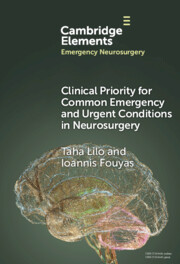References
1.Sahni, NR, Dalton, M, Cutler, DM, Birkmeyer, JD, Chandra, A. Surgeon specialization and operative mortality in United States: Retrospective analysis. British Medical Journal. 2016;354:i3571.
2.Mukerji, N, Paluzzi, A, Crossman, J, Mitchell, P, Nissen, J. Emergency neurosurgical referrals in the North East of England – trends over four years 2008–2011. British Journal of Neurosurgery. 2013;27(3):334–9.
3.Spencer, RJ, Amer, S, St George, EJ. A retrospective analysis of emergency referrals and admissions to a regional neurosurgical centre 2016–2018. British Journal of Neurosurgery. 2021;35(4):438–43.
4.Follin, A, Jacqmin, S, Chhor, V, et al. Tree-based algorithm for prehospital triage of polytrauma patients. Injury. 2016;47(7):1555–61.
5.Gormican, SP. CRAMS scale: Field triage of trauma victims. Annals of Emergency Medicine. 1982;11(3):132–5.
6.McCullough, AL, Haycock, JC, Forward, DP, Moran, CG. II. Major trauma networks in England. British Journal of Anaesthesia. 2014;113(2):202–6.
7.Moran, CG, Lecky, F, Bouamra, O, et al. Changing the ystem – major trauma patients and tTheir outcomes in the NHS (England) 2008–17. EClinical-Medicine. 2018;2–3:13–21.
8.Harvey, D, Butler, J, Groves, J, et al. Management of perceived devastating brain injury after hospital admission: A consensus statement from stakeholder professional organizations. British Journal of Anaesthesia. 2018; 120(1):138–45.
9.Ashkan, K, Jung, J, Velicu, AM, et al. Neurosurgery and coronavirus: Impact and challenges—lessons learnt from the first wave of a global pandemic. Acta Neurochirurgica. 2021;163(2):317–29.
10.Bajunaid, K, Sabbagh, AJ, Ajlan, A, et al. Consensus statement of the Saudi Association of Neurological Surgery (SANS) on triage of neurosurgery pPatients during COVID-19 pandemic in Saudi Arabia. Neurosciences Journal. 2020;25(2):148.
11.Gillespie, CSN, McLeavy, CM, Islim, AI, Prescott, S, McMahon, CJ. Rationalising neurosurgical head injury referrals: The development and implementation of the Liverpool Head Injury Tomography Score (Liverpool HITS) for mild traumatic brain injury. medRxiv. 2019:19004499.
13.Giraldo, EA, Mandrekar, JN, Rubin, MN, et al. Timing of clinical grade assessment and poor outcome in patients with aneurysmal subarachnoid hemorrhage: Clinical article. Journal of Neurosurgery. 2012;117(1):15–9.
14.Pickard, JD, Murray, GD, Illingworth, R, et al. Effect of oral nimodipine on cerebral infarction and outcome after subarachnoid haemorrhage: British aneurysm nimodipine trial. British Medical Journal. 1989;298(6674): 636–42.
15.Kennion, O, Jayakumar, N, Kamal, MA, et al. Use of an online referral service for acute neurosurgical referrals: An institutional experience. World Neurosurgery. 2022;165: e438-e445.
16.Strickland, NH. PACS (picture archiving and communication systems): Filmless radiology. Archives of Disease in Childhood. 2000;83(1):82.
17.Meyfroidt, G, Bouzat, P, Casaer, MP, et al. Management of moderate to severe traumatic brain injury: An update for the intensivist. Intensive Care Medicine. 2022;48(6):649–66.



